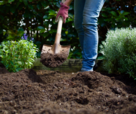WATER QUALITY IMPROVEMENTS

Earth Day Tips for Preventing Water Pollution
April is dedicated to all things earthy! Celebrate Earth Day on April 22nd and Lawn & Garden Month throughout April by protecting our local waterways and ocean! One way we can do this is by being mindful of our everyday gardening activities and their impact on water pollution. Gardening activities such as applying fertilizers or pesticides, planting, and watering can lead to stormwater pollution if not done properly. Pollutants like fertilizers and pesticides, soil and sediment, and yard waste can be carried to storm drains by runoff and end up in our local waterways without being treated.
|
Follow these tips to celebrate Earth Day while also preventing water pollution and preserving the beauty of our waterways.
-
Design and plant a drought-resistant California native garden. When designing your garden, consider using drought-tolerant or native plants which can help prevent polluted runoff. Not only do they save water (on average 80% more than conventional gardens), but they usually don’t require soil amendments or fertilizers. Native plants also typically have fewer pest problems than non-natives, which reduces the need for pesticides. Additionally, prevent soil and sediment from reaching our waterways by planting trees, shrubs, or ground cover on slopes to keep topsoil in place. You can also use mulch to prevent erosion of exposed soil patches. Get design ideas by attending the California Native Plant Society of San Diego’s Native Garden Tour on April 6th and 7th or the Olivenhain Municipal Water District’s California-Friendly Demonstration Garden showcasing sustainable landscaping techniques and a hydroponic (soilless gardening) system.
-
Properly contain or dispose of outdoor pollutants such as pet waste and yard debris to prevent them from flowing into our storm drain system. If these pollutants reach our waterways, they can pose risks to humans, wildlife, and the environment. Put litter and pet waste in trash bins, and put leaves and yard clippings in green waste bins. Make sure all of your bins are covered to prevent items from blowing out and reaching our storm drains.
-
Reduce the use of harmful garden chemicals such as fertilizers and pesticides, which can cause damage to the environment if misused. Excess fertilizers in our waterways feed algae which grows rapidly on the surface, blocking out sunlight for plants and fish. Pesticides can contaminate soil, water, and other vegetation and be harmful to wildlife and people. Be sure to read labels and follow the manufacturer’s instructions when applying. When possible, use less toxic alternatives to tackling pests and implement Integrated Pest Management (IPM), a process that manages pest problems while minimizing risks to people and the environment. Use compost or vermicompost (composting with worms) in place of fertilizers as a nutrient-rich soil amendment and to lock in moisture.
-
Manage outdoor watering practices. Irrigation runoff from yards and lawns carries pollutants into our storm drains where they are not treated before flowing into the ocean. Repair leaking or broken sprinklers and adjust sprinklers to prevent water from running off onto streets and sidewalks. Water in short cycles to allow water to absorb into the soil, and water in the early morning or late evening when it is cooler outside. Use this Watering Guide as a handy reference.
Learn more about Earth-friendly gardening by attending the many environmentally-friendly classes and landscaping and gardening events offered throughout the County. Key programs and resources include the County of San Diego’s Sustainable Landscaping Guidelines, San Diego County Water Authority’s WaterSmart Program, and Metropolitan Water District of Southern California’s Water Efficient Landscape Classes hosted by the Green Gardens Group.

|
|

|
|
Find My District
|

|
ONLINE SERVICES
Report Stormwater Pollution
Report observed pollution to the correct jurisdiction.
Citizen Access Portal
Research property information and permits. Apply for some permits online.
GIS Maps
Find property information including zoning designation with our web-based mapping tool.
Watershed Protection Website
sandiegocounty.gov/stormwater
Learn more about available water quality rebates that you could apply to your property!

Project Clean Water efforts are focused on providing a centralized point of access to water quality information and resources for San Diego County Watersheds. Click HERE to visit Project Clean Water’s website.
|

|
|